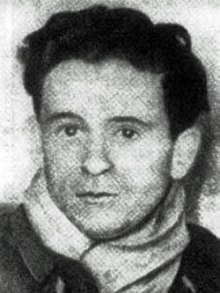Pierre Georges
You can help expand this article with text translated from the corresponding article in French. (February 2014) Click [show] for important translation instructions.
|
Pierre Georges | |
|---|---|
 | |
| Born | 21 January 1919 Paris, France |
| Died | 27 December 1944 (aged 25) Habsheim, France |
| Nationality | French |
| Occupation | Resistance leader |
| Known for | Colonne Fabien |
Pierre Georges (21 January 1919 – 27 December 1944), better known as Colonel Fabien, was one of the two members of the
Life
Pierre Georges was born to a baker's family on 21 January 1919 in Paris. He fought for the Republican side during the Spanish Civil War until the end of the International Brigades in 1939. In 1940, Georges joined the French Resistance in the Francs-Tireurs et Partisans, at the time still largely operating by sabotaging German equipment in France.
On 2 August 1941
On 21 August 1941 Pierre Georges, who then went by the name of Frédo, and his companion Gilbert Brustlein, helped by two other members of the
Five days after the surrender of Paris Albert Ouzoulias ("Colonel André") of the national committee of
Colonel Fabien was killed in a mine explosion at Habsheim, on the Alsace front, on 27 December 1944.[6] Two other leaders died at the same time. This gave rise to various conspiracy rumors.[7]
Honours

- The former Place du Combat in Paris was renamed Place du Colonel Fabien in honour of Pierre Georges.
- The Colonel Fabien.
- The French Communist Party headquarters, located at the Place du Colonel Fabien, is often so called.
Likewise, many streets in towns with communist mayors are named Colonel Fabien.
References
- ^ Johnson 1995.
- ^ Lallier & Logak 2015.
- ^ Porin 2004.
- ^ Ce jeudi 21 août 1941 ... L'Humanité.
- ^ Hansen 2014, p. 31.
- ^ a b Pigenet 2014.
- ^ a b Calvès 1996.
Sources
- Calvès, André (1996). "La Colonne Fabien" (in French). Retrieved 2015-04-04.
- "Ce jeudi 21 août 1941, 8 heures". L'Humanité. 1994-08-23. Retrieved 2015-06-06.
- Hansen, Randall (2014). Disobeying Hitler: German Resistance After Valkyrie. Oxford University Press. p. 31. ISBN 978-0-19-992792-0. Retrieved 2015-06-06.
- Johnson, Douglas (6 December 1995). "Obituary: Albert Ouzoulias". The Independent (UK). Retrieved 2015-05-21.
- Lallier, Rose; Logak, Elisabeth (2015). "Albert Ouzoulias (1915 – 1995)". Figures humaines. Archived from the original on 2015-06-03. Retrieved 2015-05-21.
- Pigenet, Michel (5 September 2014). "La colonne Fabien, de la Mutualité à Sigmaringen". L'Humanité. Retrieved 2015-04-04.
- Porin, Axel (2004). "Albert Ouzoulias". La Résistance en Ile-de-France. AERI. Retrieved 2015-05-21.
